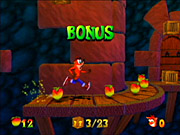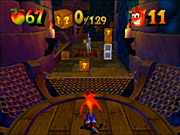Crash Bandicoot: The Wrath of Cortex is what happens when a developer whose track record mostly consists of titles based on licenses like Toy Story, A Bug's Life, and the Muppets gets handed an actual game franchise--the end result is a disjointed pile of middling content that closely resembles the property it's based on but doesn't attempt to do anything except be good enough to cash in on the license. So it's no surprise that this Crash game is now showing up on the GameCube almost a year after its original appearance on the PS2. Your goal in Wrath of Cortex is to once again stop Dr. Cortex's evil plans, this time by jumping, spinning, and belly-flopping through 24 levels as Crash and six levels as his genius kid sister, Coco.

Traveller's Tales has taken the reins of Crash Bandicoot from Naughty Dog, and it has seen fit to nearly copy the gameplay of the previous Crash games, adding very few twists. Of course, the Crash series has always had a sort of me-too feel, taking bits and pieces of other platform games and fitting them with different guises. It's almost as if the original game's design document had blanks for "sound-related adjective" and "obscure animal," and the creators replaced "sonic" and "hedgehog" with "crash" and "bandicoot" and then went from there, cribbing occasionally from Mega Man and Mario as well. That feeling of unoriginality was further amplified when Traveller's Tales brought Crash to the next generation of consoles but adhered to the same old gameplay formula. Wrath of Cortex's levels, for the most part, are the same linear valleys, corridors, and tunnels from the first Crash games, and the camera is the same problematic low-angled one that causes problems with depth perception, making gap jumps and dodging incoming enemies or projectiles needlessly difficult.
Thankfully, the levels are often broken up by some short yet enjoyable sequences in vehicles. You'll occasionally get to pilot a variety of air, land, and sea craft though part of a level or an entire level. These parts of the game are always much more fun than the standard gameplay, and their production values are so much higher than the production values in the rest of the game that it's a shame they are the smaller portion of the game. Hopping into a vehicle is always a nice surprise, but you'll have to pause and refer back to your manual to look at all the capabilities of the craft you're in, since the game doesn't give you all the details. The vehicles aren't complicated, but each behaves differently enough that a one-time informational pop-up would have been useful, as you are often immediately in danger as soon as the vehicle sequence starts. It's a wonder that a game that mimics so many other platform game conventions has ignored the common practice of telling the player what to do with a newly acquired item. It's a minor problem, but one that is indicative of the lack of polish in Wrath of Cortex.
The generally poor execution in this game is only highlighted by its release on the GameCube so closely after Super Mario Sunshine. The liner paths of a Crash level give you a claustrophobic feeling after playing in the huge, open areas in Sunshine. Even the method used in the progression of the game is markedly poorer than the one used in Sunshine. You move between levels using a "virtual reality hub," which is just a series of portals laid out side-by-side in a nondescript blue room, and there's no plot progression to speak of, so after the opening cinematic, you're just using the hub to move between levels until you reach the end. When you play a level as Coco instead of Crash, there's no explanation or warning given--you'll simply enter the level's portal as Crash and come out the other end as Coco. It's not all bad, but compared with Sunshine, it seems very uneven. Graphics aficionados who have played Sunshine are in for some disappointment right from the opening sequence, which has Crash water-skiing across a flat blue-and-white surface that approximates water much the same way "3" approximates pi. While Sunshine's water effects are a tough act to follow, the graphics throughout the rest of Crash are simply average as well.
Further compounding the shortcomings of Wrath of Cortex is the quality of its port to the GameCube. While the lengthy load times of the original PS2 version have been more or less addressed by the port, Crash on the GameCube has some annoyances that make you wonder why Nintendo would allow a port of such poor quality to be published on its system. The most grating problem is the sound. The sound volume seems random--sometimes portions of dialogue, even from the same character, will be too quiet to hear, and increasing the volume on your TV will only get you an earful when the action starts up again, as some sound effects are much louder than any of the dialogue. In particular, the first vehicle level, in which you fly a glider, has a loud, unidentifiable thunking noise playing during the entire level that completely drowns out all the other sound effects. The graphics engine also exhibits signs of a lackadaisical port. There are multiple points in the game where the frame rate noticeably drops. It never crawls, but for a game with a level design held over from the days of PlayStation polygon budgets, any frame rate drop at all is a mark of laziness.

As if in apology, the GameCube port offers Crash Blast, a minigame that can be downloaded to your GBA. It's nothing special, though. Crash Blast is basically a shooting gallery in which Crash stands at the bottom center of the screen, firing his fruit-launching bazooka at portraits of enemies from the game that pop up and down or fly across the screen. Crates appear that can be shot for extra ammo, and sometimes a target will be a friendly one that you'll have to avoid shooting. That's it. None of the targets are animated apart from their movement across the screen, which is an actual step back from the days of Hogan's Alley on the NES, in which at least sometimes the paper targets would spin to face you.
Crash Bandicoot: The Wrath of Cortex on the GameCube is a perfunctory port of a perfunctory game. If you like beating challenging platform games, there is plenty of challenge in Crash, as always. After completing a set of six levels, you can go back to five of them and complete additional goals to obtain a gem and a relic. A 100-percent completion rating for the game will net you a special ending. On the other hand, if you are more interested in a platform game for seeing cool scenes and playing interesting scenarios, there is far less of that to be found. Overall, Crash Bandicoot: The Wrath of Cortex hangs on too hard to the style and design of the previous installments in the series and is too disarrayed to be exciting in the evolving platform genre, and the low quality of this port doesn't help at all.